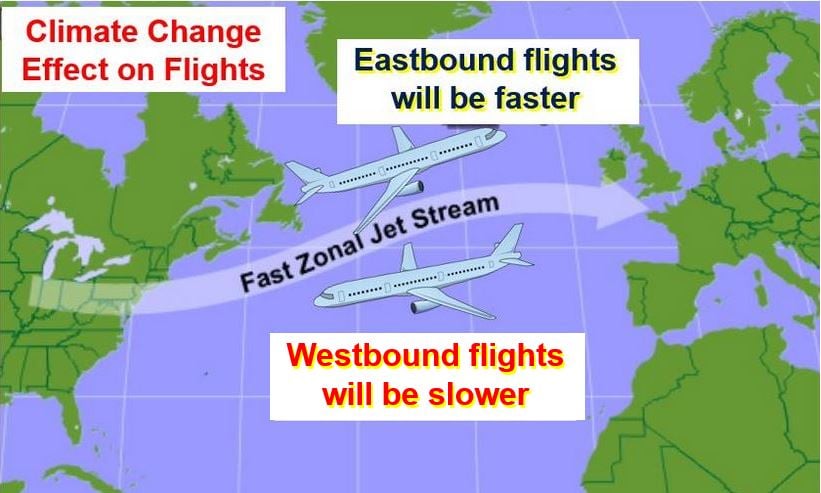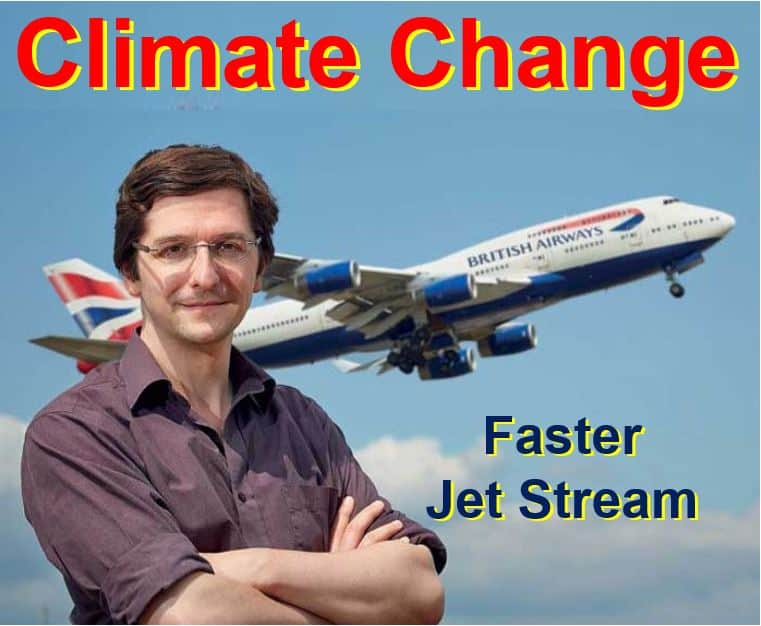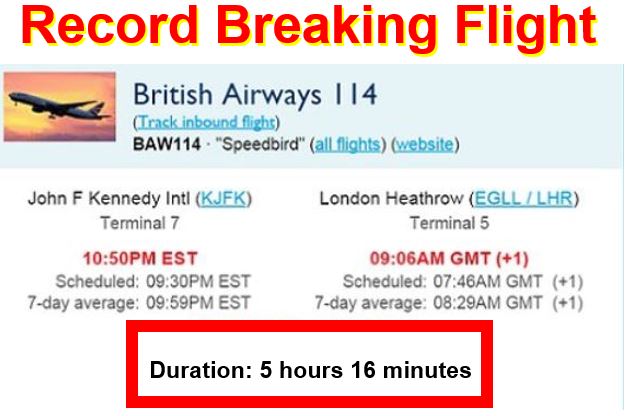UK to US flights will be longer due to global warming (climate change), but US to UK journeys will be shorter, a new study has found. When we think of climate change, we tend to focus on the air temperature at ground level, but atmospheric conditions at 35,000 – the average cruising altitude for passenger planes – also undergo changes.
The behaviour of atmospheric winds is strongly linked to temperatures at flight cruising altitudes. The winds are changing in response to higher temperatures due to climate change, Dr. Paul Williams, from the University of Reading in England explained in the peer-reviewed journal Environmental Research Letters (citation below).
A journey by plane from London to New York will take up to five minutes longer if CO2 (carbon dioxide) levels double, while the return flight will be four minutes shorter, according to Dr. Williams’ calculations.
 The jet stream – which speeds up planes flying eastward and slows down westward-bound aircraft – will be travelling faster in future due to climate change.
The jet stream – which speeds up planes flying eastward and slows down westward-bound aircraft – will be travelling faster in future due to climate change.
Jet stream will be moving faster
This is because the jet stream, which moves eastwards from North America towards Europe, will be travelling at a faster speed, so the overall round trip will be 1 minute longer.
Dr. Williams, a Royal Society University Research Fellow, said:
“Transatlantic aircraft may be in the air for an extra 2,000 hours each year, adding $22 million to airline fuel costs, and increasing carbon dioxide emissions by the equivalent of 7,100 British homes.”
“Apart from potentially raising ticket prices, passengers will have a significantly increased chance of being on a record-breakingly fast eastbound flight across the Atlantic. However, they will also have a significantly increased chance of experiencing delayed arrivals in North America.”
Atlantic crossing route to get even more congested
The north Atlantic crossing route is already super busy with about 600 flights each day. When aircraft spend a minute extra on each round trip, that corridor will become even more congested and will produce more pollution.
The extra 7.2 million gallons of jet fuel used up as a result of a change in jet stream speed would mean an additional 70 million kilograms of CO2 being emitted annually.
 Dr. Williams says that CO2 emissions by planes will be even greater than they are today because they will (on average) spend longer in the air during round-trip London-to-New York flights. (Image: adapted from images.iop.org)
Dr. Williams says that CO2 emissions by planes will be even greater than they are today because they will (on average) spend longer in the air during round-trip London-to-New York flights. (Image: adapted from images.iop.org)
Regarding wind patterns, Dr. Williams said:
“Airlines are constantly monitoring the wind patterns, and using some complicated mathematics to calculate the fastest routes. I have used those same mathematical routing algorithms, but instead of applying them to today’s winds, I used winds generated from climate model simulations.”
“We can crank up the carbon dioxide in the model, look at the effects on the winds, and then see how the flight routes are modified.”
IF CO2 levels double what will happen?
In this latest study, Dr. Williams modelled flight times over a two-decade period if CO2 levels doubled, and compared them to passenger aircraft flight times calculated from daily winds from a control run of the climate model under the atmospheric conditions that existed during pre-industrial times.
Dr. Williams calculated that the average tailwind speed on a London-bound flight from New York flying at an average cruising altitude would be about 15% faster – from 21.5 m/s to 24.6/ms.
A passenger plane’s cruising speed would be faster traveling east from the US to Europe and slower westbound (from Europe to the US).
During the winter, a London-to-New York flight would take five minutes longer than it does today, while the return trip would be four minutes faster. Consequently, a round trip would be one minute longer.
 Expect to see more of these record-breaking flight announcements in future. (Image: adapted from viewfromthewing.boardingarea.com)
Expect to see more of these record-breaking flight announcements in future. (Image: adapted from viewfromthewing.boardingarea.com)
Dr. Williams said:
“Car journeys must take place along the network of roads, but plane journeys are obviously not constrained in this way. Planes are free to vary their route from one day to the next.”
“They do this to benefit from wind patterns and reach their destinations as quickly as possible. We know that climate change is altering the winds at high altitudes. However, very little was known about the impacts on flight routes and journey times.”
Expect more records broken in future
The likelihood of a New York-to-London flight taking less than 5 hours and 20 minutes will increase by more than 100%, Dr. Williams calculated – the probability will increase to 8.1% from 3.5%.
The fastest New York-to-London (non-Concorde) passenger flight was 5 hours and 16 minutes – recorded on 8th January, 2016, when the jet stream was unusually fast.
The probability of a westbound flight lasting over seven hours will increase to 15.3% from 8.6%. So expect lots of flight-time records broken on eastbound journeys and delays on the westbound trip.
Dr. Williams explained:
“We have previously studied how aircraft turbulence will respond to climate change. We projected large increases in both the amount and strength of clear-air turbulence on transatlantic flights. Looking at the impacts of climate change on flight routes was a natural next step.”
Other studies have focused on what the effects of warmer, less dense (lighter) air are on lift and take-off weights, and whether it is worth redirecting aircraft away from ice-supersaturated air to avoid contrail formation and the consequent climate warming.
Regarding high-altitude winds across the world, Dr. Williams said:
“So far, I have looked only at transatlantic flight routes. However, the high-altitude atmospheric winds all across the globe are changing in response to climate change. A future research priority will be to study the impacts on other flight routes.”
Citation: “Transatlantic flight times and climate change,” Paul D Williams. Environmental Research Letters. Published 10 February 2016. DOI:10.1088/1748-9326/11/2/024008.
Video – Transatlantic flight times altered by climate change
Dr. Williams explains that his new studies found that the jet stream winds along the flight routes between London and New York are getting stronger because of global warming.
This increase in the jet stream winds will have an impact on passengers’ flights.
